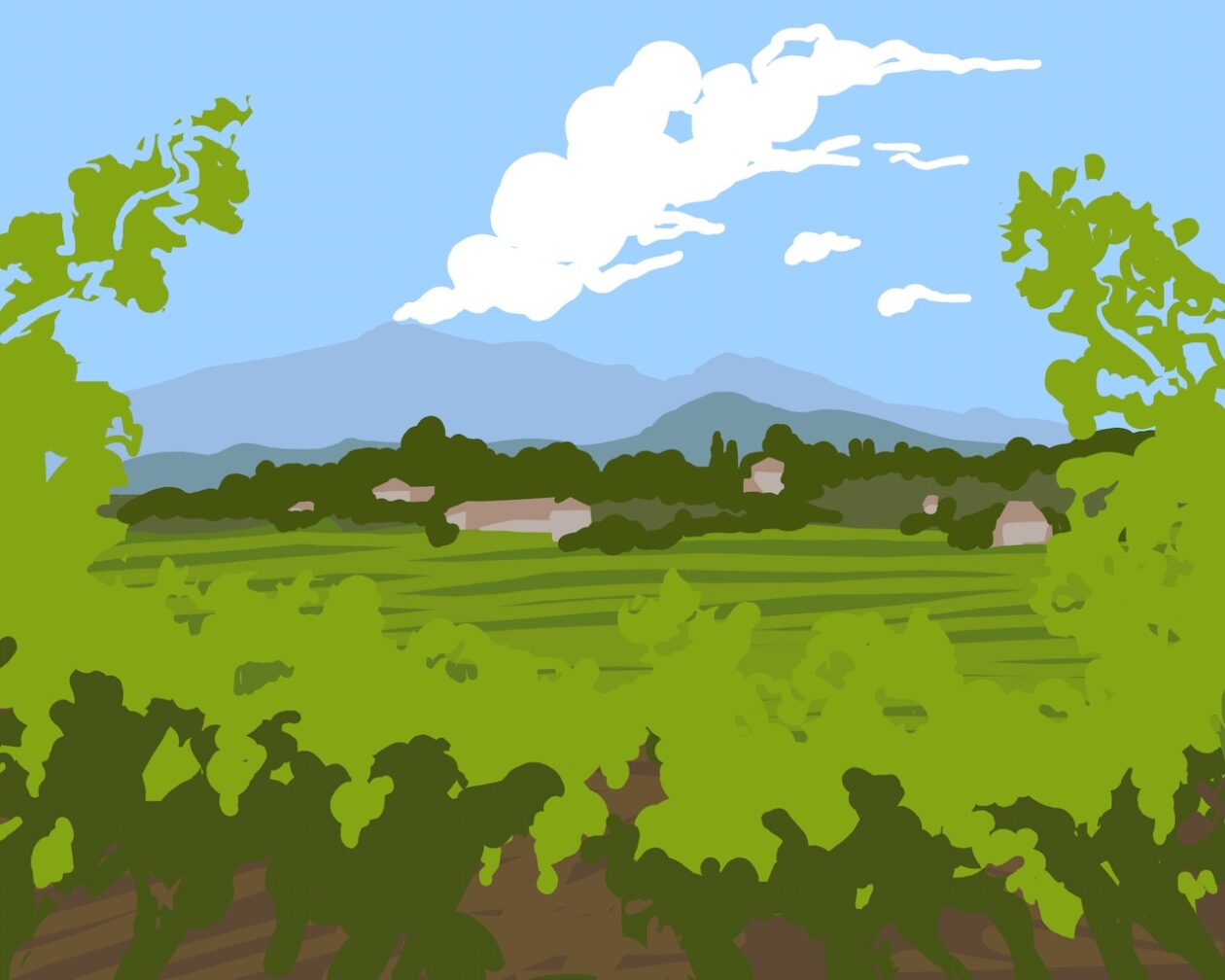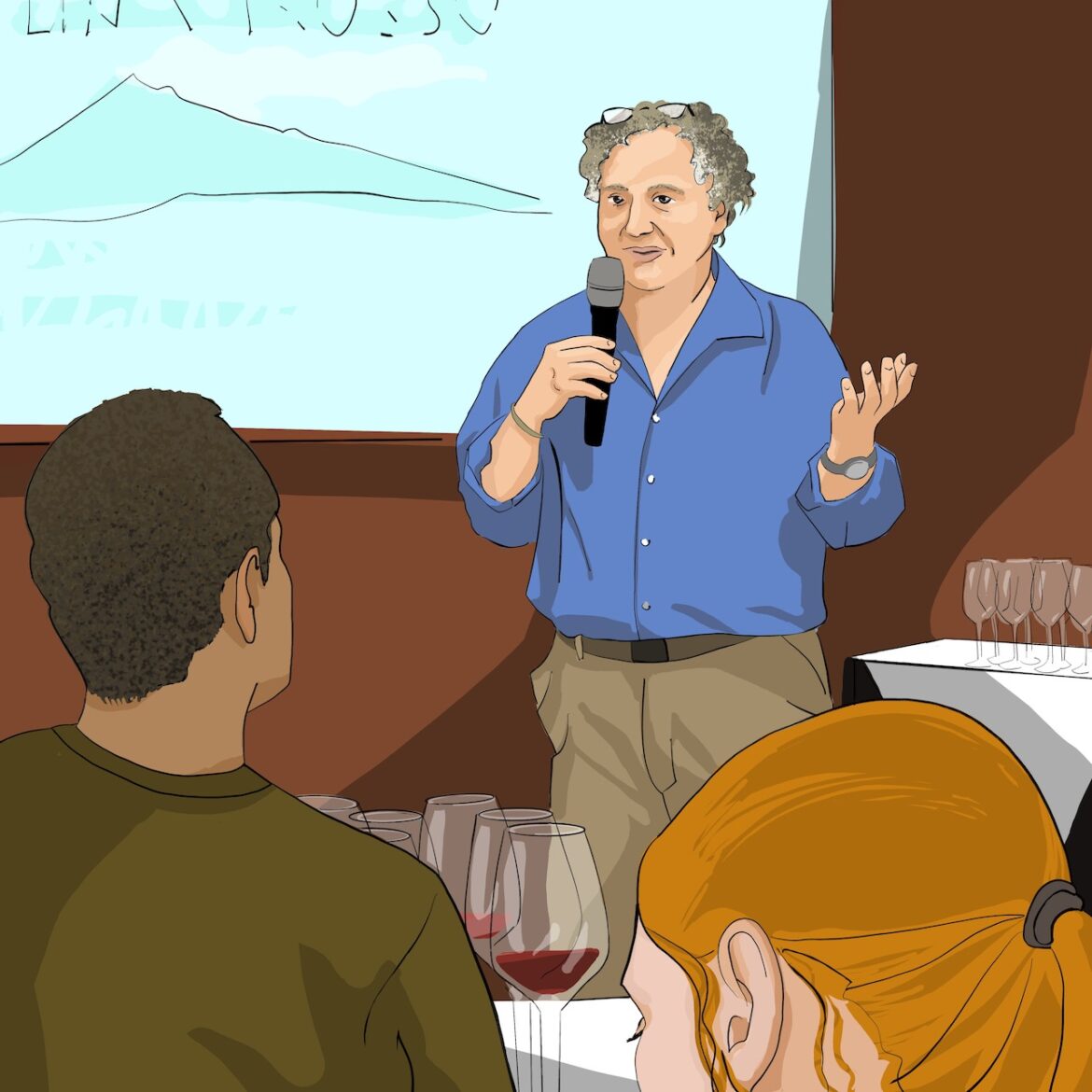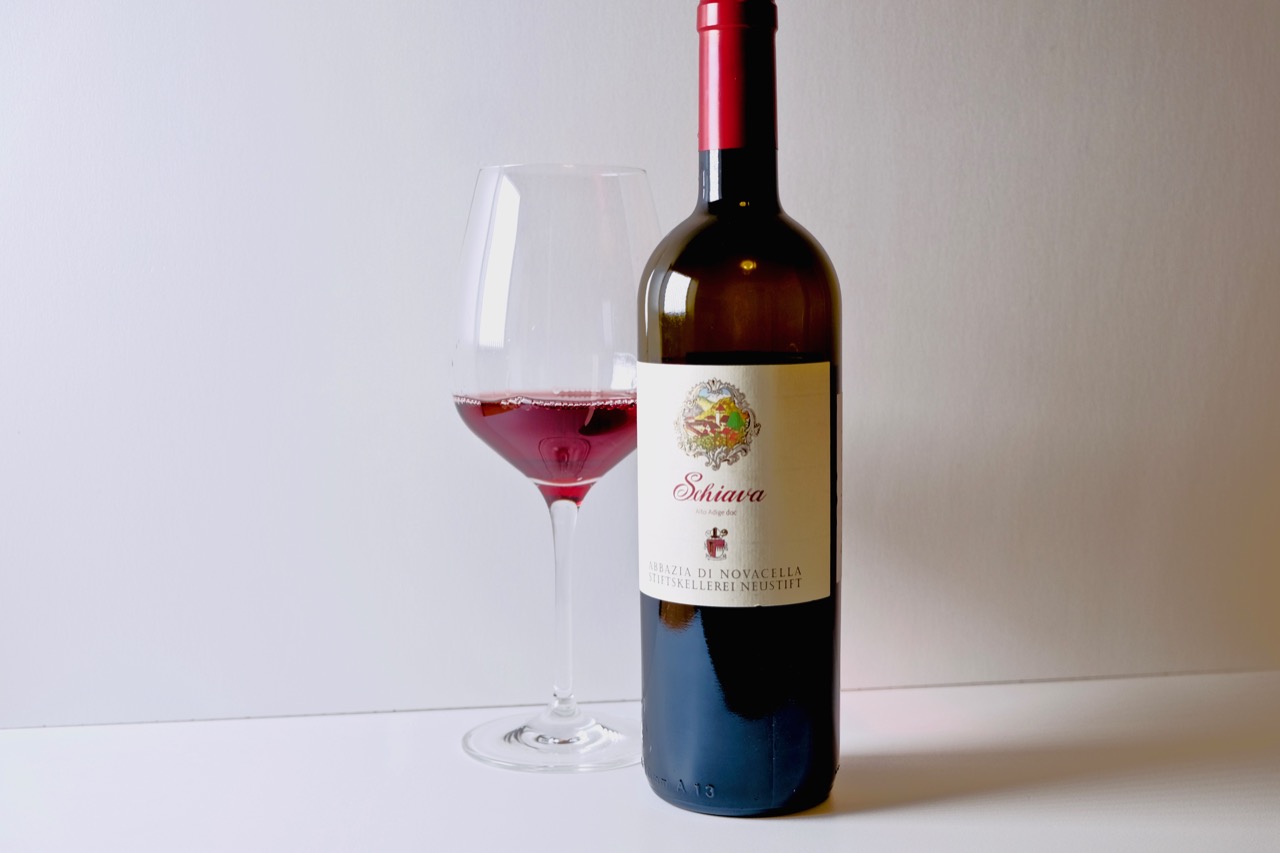Etna is a terroir in flux. Fingers of lava eradicate vineyards in a slow instant, while ash accretes more gradually. On Etna, it’s said, there is no need to fertilize, because the soil comes from the sky.
Before phylloxera, Etna boasted 200,000 hectares of vineyard. As the louse swept across Europe, Etna was briefly spared thanks to its inhospitable volcanic soils. But the vines inevitably succumbed, and re-establishment was rocky. By the 1990s, only a half a dozen producers were bottling wine. Today there are nearly two hundred, but the vineyard area is still relatively minuscule, only 1,300 hectares in a clockwise crescent, north through southwest.
In September 2023, I visited the mountain for an event called Etna Days, a three-day immersion in the wines of the volcano. It was my fourth visit there, but the longest so far. It began with a seated blind tasting of six whites and eight reds sourced from different slopes of the mountain (my notes follow below). The event also included a walkaround tasting of producers of the Etna DOC consorzio, plus a day and a half of producer visits.
The kickoff tasting was led by Kerin O’Keefe, an American critic and expert on Italian wines, and Marco de Grazia, of Tenuta delle Terre Nere in Randazzo. De Grazia rose to prominence in as one of the so-called Barolo Boys, whose modern, international aesthetic revolutionized Piemontese winemaking in the 1980s and 90s — some say for better, some for worse. De Grazia’s family is Sicilian, and he returned to the island to launch his own wine project whose inaugural bottling was in 2002. His winery, located on contrada Calderara, on the north slope of the mountain, draws fruit from 45 hectares of estate vineyards that lie between 400 and 1,000 meters.
De Grazia speaks knowledgeably, eloquently, of the mountain’s past and its future potential. And although he had framed this tasting as a survey of soil, site, and style, he acknowledged that fourteen wines are an insufficient tutor. It would be up to us to derive the full lesson of the mountain.
What follows is a lightly edited transcript of De Grazia’s remarks before and during the tasting.
I’m going to speak some reckless words, and I want you to listen to them recklessly, as a wonderful old Chinese man was telling me.”[i]
Fine wine is work. Difficult work. Long work. It takes patience, it takes confidence. Among many other things, it takes vision. The responsibility of the winemaker is extraordinary, because winemaking is a reflection of our civilization. The winemaker, just like you, must devote tremendous time to tasting, and not only his own wines. If the winemaker is not capable of distinguishing between a good, an excellent, and a great wine, it’s mathematically impossible for him to make a great wine.
Some people think that the winemaking is a process, and it is. But the really important thing is that there must be a moment in which you decide that there is a way of doing things: an end, a direction, somewhere that you want to go. I think this is fundamental. Not only for winemaking but everything. One of my wine teachers, [Denis] Dubourdieu, had a sailboat on his first wine label. He said there’s a similarity between sailing and winemaking. If you don’t know where you’re going, there’s no such thing as a good wind. If you don’t have a compass, if you don’t have a direction, if you don’t know where you want to go, there’s no way you’ll get there. And the same thing with wine. You have to have that kind of a direction, that kind of a vision. So it’s true that it’s a process, but it’s a process that’s guided by intelligence, imagination, science, by technical things. ‘Teknik’ in ancient Greek meant ‘art.’ So technique and art go together. Sometimes technique is a proof of someone’s honesty in winemaking, as in art.
The wines of Etna have characteristics of gentility. They are not very thick in color, they are not very powerful in body. They indeed have characteristics of wine that can be described as “fine.” A big wine is easy to make, a fine wine is difficult to make. The nature of fine wine is discretion. Fine wine doesn’t have to flex its muscles. Doesn’t need to. Fine wine has no need to raise its voice to make a point. It doesn’t need to. It just happens to express its point with discretion. You’ll find that, I hope, in the wines you’ll be drinking.
The winemaker’s hand has to be as invisible as possible. It just has to draw the baby out, as a midwife; just has to draw the character of the vineyard out. This is very important here because of the extraordinary diversity of the vineyards that we have. So if the winemaker’s as fine as the wine he’s trying to make, he will try to keep his hand down and let the vineyard express itself.
I hope these wines give you one thing, which is to deliver you, with joy, away from the sometimes difficulties and ugliness of the world.
On the white and rosé Etna wines
White wines have a saline character, which does not mean acidity. In fact the acidity is quite low, with respect to the average white wine, but the saltiness makes it extremely agreeable, and takes the place of acidity on the palate with Sicilian food.
In the old world, wine is red. Where you make great reds, you hardly ever find whites. You find more whites as the reds decline in quality. Milo [on the east slope of Etna] is a place where you make whites because you can’t make reds. We have to be honest about that. The weather would not allow that. I know, I’ve tried. [But] you can make very good rosé.
On latitude and elevation
If you just think about it a fraction of a second, you will say Hm, these wines don’t taste like southern wines. At all. In fact, not only do they not taste like southern wines — warm, heavy, overly rich, overdone, alcoholic, and so on — but they also really don’t resemble northern Italian wines, either. They seem to go further, further, further up, in latitude. Italy is a peninsula, north south, or northwest to southeast. In Piedmont, the average altitude of the vineyard is 200m. As you go to Tuscany, it’s 350m or 400m. You go further south to Naples, it’s 400m to 600m. You come over here, it’s 600m to 900m, until you can’t go much higher. But Lebanon, in the Beqaa Valley, you’re at 1,000m, right? The further south you go, the higher you must go in altitude to get the fragrance and freshness, to get the temperature excursion between day and night that can allow you to deliver wine with this kind of balance, drinkability. Wines that you can drink with pleasure every day.

On the Contrada system
Okay, I started this. I am the culprit. My first wine in 2002 was Guardiola, and it was the first wine that had the contrada on it. And then the anti-fraud commission suppresses my wine and I had huge fines. So I decided I’m going to write all the mayors of all the twenty townships in Etna, saying Look, get your office and let’s map this out. It’s important. Finally it passed with the consorzio through the ministry of agriculture in Rome. Why? It was important. Is it necessarily true that one contrada produces superior wine? Is it the equivalent of a cru? It isn’t. It was very easy to do these things in the 17th and 18th century, when you had, in France, a centralized government, and you had a king who would go around and say here you plant, here you don’t plant, and if you do plant, off with your head. In a democracy, your next-door neighbor will not accept that you have a grand cru and the other one has a premier cru. There would be complaints, and endless war. So this is a beginning, an important beginning to understand that there are enormous differences.
On the alcohol levels
The reds all have, and always have had, high alcohols. There are some vintages — 2012, 2014, where the wines tend to go over the top, 2004 as well — and then you feel a bit of the alcohol. But otherwise, the alcohols are really very well integrated into the wine. The grape varieties that work, planted by the Greeks, all were planted at high altitudes, and many of them were planted on volcanic soils. From Naples all the way to the Adriatic side, they’re all on volcanic soils. High altitude, late ripening grapes, all October, November, both white and red. And all are very high alcohol. Why? It works! Farmers can’t afford to make mistakes. They need to have certainties, for survival. Eventually you get the right grapes in the right places.
On the prospect of an Etna DOCG
Have you ever had, or heard of, Romagna Albana? It’s a DOCG. Has it done it any good? No. Does it bring anything to, or take anything away? There are people in Etna who want it. If they vote, they want it, we’ll get it. It won’t make any difference to the wine.
On old vines
Old vines are better than young vines. They deliver better wine, for plenty of reasons. They go deeper, they are not as susceptible to rain. Generally speaking, in Calderara, the pre-phylloxera seems to be much more delicate in an odd way. To me, sleekness is the sign of very fine wine, so the pre-phylloxera has tannins that are so refined that they tend to lengthen the wine on your palate. Some tannins tend to cut your palate off. These are so fine that the flavors keep on and linger. Or you can just say it’s like smoking unfiltered.
On Etna terroir
Another extraordinary, almost unthinkable, thing, is that here we have terroirs that change. In 1981 there was a lava flow that completely annihilated one contrada; there’s only a little island left of that contrada that’s surrounded by lava, where I make some wine. Half a hectare. Otherwise that contrada no longer exists. It takes hundreds and hundreds of years before a lava flow turns into plantable soil. Where my estate is, Calderara, there are points in Calderara which in my opinion is a grand cru for many reasons, but there are parts of Calderara which I can only devote to rosato, because the grapes won’t ripen, because that particular patch of soil, the soil is so deep that it delivers humidity and you cannot get the grapes to ripen fully, so you have to get them one week before, and you make a wonderful rosé, but that’s not what a grand cru is. Every farmer says, my wine is best, so we can’t really trust oral tradition very much either. We started out vinifying fifty different Nerello Mascelese every year. Young vines, old vines, this and that. In twenty-some years we have an idea, but you can only do so much in a lifetime. In time, things should get more precise.
I asked him a question…
If you look ahead 20 years, what developments are you watching, and thinking about, and what developments are you afraid of?
…and he replied:
I’m afraid I won’t be here anymore! Listen. I’ll answer in a roundabout way, okay?
History is an extremely fine teacher. People always think of phylloxera and about the devastation that it brought on vineyards. Before phylloxera, the production of Etna was 1 million hectoliters — roughly four times the size of Burgundy. Half of it was consumed in Sicily, half of it was exported. But very few people understand that in 70 years after phylloxera we also had two world wars. Millions and millions of people dying, and as many millions emigrating. So we have lost so many things, and particularly in agriculture. We have to re-learn what we’ve lost.
I think the next 20 years will find that the white wines have greater potential improvement as we understand better where they should be planted and how they should be planted. The red wines will get even more complex in, how shall I say it, the understanding. I’ve had vineyards in Santo Spirito, and I’ve come to the understanding that there are three different areas within it that yield very different wines. So it’ll be up to the next generation to fine tune the areas and make them even more adherent to the character they have. The winemaking will have to follow the curiosity in order to understand the form, to deliver something that that respects that precision of character year after year. That’s one of the most precious things of Etna. There are a few places in the world of wine where you can drink very fine wine immediately, and you can age it. Here, and Burgundy, are the first two that come to mind. Chianti Classico. The capacity of wine to deliver all the nuances, and then to refine them as they age, is the prerogative of very few wine regions. These are things that we’re discovering.
Tasting Notes
2022 Graci Etna Bianco
85% Carricante, 15% Catarrato, grown on the northern slope at 600m. Stainless steel vinification and aging, 8 mos. on lees. 12.5% ABV
White peach, laurel, firm but not crazy acidity.
2022 Az. Agr. Iuppa Etna Bianco Superiore
90% Carricante, 10% Catarratto bianco lucido grown on the eastern slope (Milo) at 600m. Stainless steel vinification and aging. 12.5% ABV
Almond, orchid, nut, peach and pear nectar. Short finish, somewhat bitter and lightly salty.
2022 Gagà Etna Bianco
100% Carricante grown on a south-southwest slope at 700-900m. Stainless steel vinification, and aging 6 mos. on lees. 12.5% ABV
Peach and pear nectar, rounded and salty. There’s a hole in the midsection, and it lacks nerve.
2022 Barone di Villagrande Etna Bianco Superiore
90% Carricante, 10% other native Etna grapes grown on the eastern slope at 700m. Stainless steel vinification and aging. 12.5% ABV
Sharp citrus aromatics. Nice herbal-citrus midsection and super saline on the finish. Wow! So salty. Lovely wine.
2022 Maugeri Frontemare Contrada Praino Etna Bianco Superiore
100% Carricante grown on the eastern slope at 700m. Stainless steel and tonneaux vinification and aging. 12.5% ABV
Almond, peach, dried sage. The mid-palate is salty with almond, bitter almond, peach skin.
2022 Tenuta delle Terre Nere Santo Spirito Etna Bianco
100% Carricante grown on the northern slope at 700-800m. Barrique vinification and aging. 13% ABV
Oak and vanilla aromas. Rounded palate, evolved and silken, with some saltiness with bitter herbs. Could benefit from aging.
2021 Terra Constantino Etna Rosso
90% Nerello Mascalese, 10% N Cappuccio grown on the southeastern slope,450-550m. Stainless steel and medium-sized oak vinification and aging. 13.5% ABV
Berries, basil, oak (a bit distracting). Rounded and fresh-faced with pleasant red fruits, herbs, grip.
2021 Benanti Contrada Monte Serra Etna Rosso
100% Nerello Mascalese grown on the southeastern slope at 450m. Stainless steel and used tonneaux vinification and aging. 14.5% ABV
Fresh red fruits, some volatility. Grippy, a little hot. Surprising.
2021 Tenute Nicosia Contrada Monte Gorna Etna Rosso
90% Nerello Mascalese, 10% Nerello Cappuccio grown on the southeastern slope at 700-750m. Stainless steel, barrique, and cask vinification and aging. 13% ABV
Sweet cherries, blueberry, fresh herbs, brushy herbs. Palate reads a bit like red grapefruit. Drying tannins, nice acidity, vertical and linear. Would benefit from bottle age.
2021 Masseria Setteporte Etna Rosso
100% Nerello Mascalese grown on a south-southwest slope at 700-730m. Concrete and oak vinification and aging. 14.5% ABV
Deep color, lots of extract. Baked blue fruits, red fruits, super ripe with light volatility. Palate rounded and silky with well integrated tannins; it’s the ripest, fruitiest of the reds.
2021 Tenuta di Fessina Erse Etna Rosso
90% Nerello Mascalese, 8% Nerello Cappuccio, 2% Minella and Carricante (both white) grown on the northern slope at 750m. Stainless steel vinification and aging. 13.5% ABV
Lightly funky, a little sour and thin.
2021 Tenuta Tascante Ghiaia Nera Etna Rosso
100% Nerello Mascalese grown on the northern slope at 600m. Large Slavonian cask aging. 13% ABV
Oxidative, lightly volatile, red fruits, cranberry. Direct and targeted tannic structure. Crystalline red fruits at the finish. Refined.
2021 Quantico (Emanuele Raiti) Etna Rosso
96% Nerello Mascalese 4% Nerello Cappuccio grown on the northern slope at 600-750m. Vinification and aging in 50/50 steel and used barriques and tonneaux. 13.5% ABV
Cedar wood, juniper, red fruits. Rounded, integrated tannins, ample volatile acidity, drying, with a flame of acidity at finish.
2021 Tenuta delle Terre Nere Dagala di Bocca d’Orzo Etna Rosso (monopole)
100% Nerello Mascalese grown on the northern slope at 800m. Vinification and aging in barrique and tonneaux. 14% ABV
Dark color, dark red and black fruits, a bit of dried herbs, juniper, cedar wood. Super silky tannins, buffed but firm, with modest acidity.
[i] The remark is attributed to Daoist philosopher Zhuangzi.
I’m grateful to the Consorzio for sponsoring my travel to the region. The wines were samples for review.




